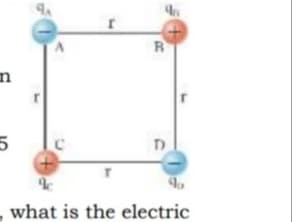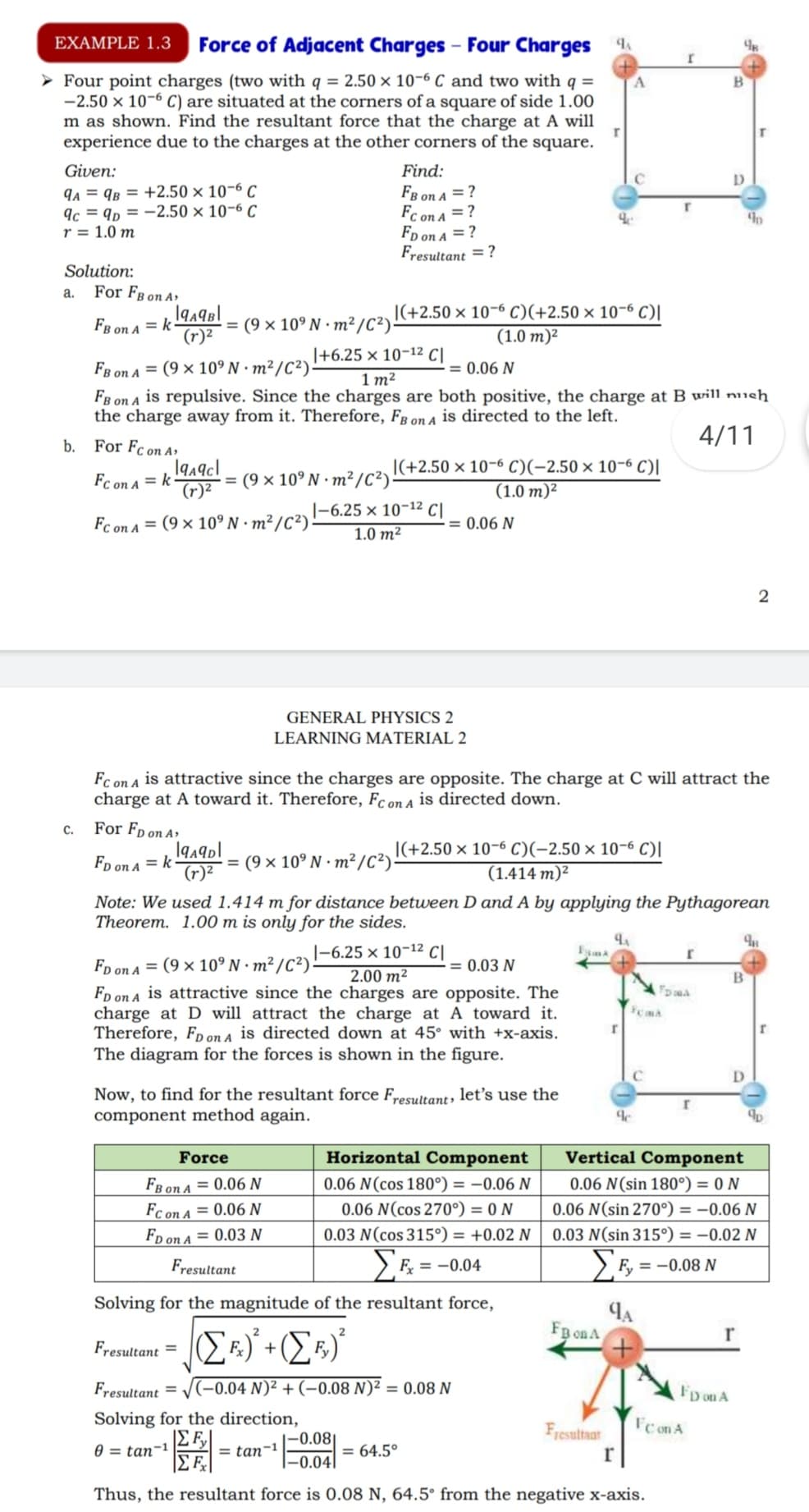Glencoe Physics: Principles and Problems, Student Edition
1st Edition
ISBN:9780078807213
Author:Paul W. Zitzewitz
Publisher:Paul W. Zitzewitz
Chapter21: Electric Fields
Section: Chapter Questions
Problem 51A
Related questions
Question
2. Suppose that the charges in Example 1.3 are situated as shown
in the figure. Find the resultant electric force on the charge at A.

Transcribed Image Text:R
- what is the electric

Transcribed Image Text:EXAMPLE 1.3
Force of Adjacent Charges - Four Charges 1.
> Four point charges (two with q = 2.50 × 10-6 C and two with q =
-2.50 x 10-6 C) are situated at the corners of a square of side 1.00
m as shown. Find the resultant force that the charge at A will
experience due to the charges at the other corners of the square.
Given:
Find:
qa = 9B = +2.50 × 10-6 C
9c = 9p = -2.50 × 10-6 C
r = 1.0 m
FB on A = ?
Fc on A = ?
FD on A = ?
Fresultant = ?
Solution:
For FBon A
a.
|(+2.50 × 10-6 C)(+2.50 × 10-6 C)|
FB on A = k
(r)2
(9 × 10º N · m²/C²)
(1.0 m)²
|+6.25 × 10-12 C|
1 m²
FB on A is repulsive. Since the charges are both positive, the charge at B will nch
the charge away from it. Therefore, FB on A is directed to the left.
FB on A = (9 × 10° N · m²/C²)
= 0.06 N
4/11
b.
For Fc on A
|(+2.50 × 10-6 C)(-2.50 × 10-6 C)|
(1.0 m)²
Fc on A = k
(r)2
= (9 × 10° N · m²/C²)
|-6.25 × 10-12 C|
1.0 m²
Fc on A = (9 × 10° N · m² /C²)
= 0.06 N
2
GENERAL PHYSICS 2
LEARNING MATERIAL 2
Fc on A is attractive since the charges are opposite. The charge at C will attract the
charge at A toward it. Therefore, Fc on A is directed down.
c.
For Fp on Ar
|(+2.50 × 10-6 C)(-2.50 × 10-6 C)|
FD on A = k
= (9 x 10° N · m²/C²)·
(r)²
(1.414 m)²
Note: We used 1.414 m for distance between D and A by applying the Pythagorean
Theorem. 1.00 m is only for the sides.
|-6.25 × 10-12 C|
Fp on A = (9 × 10° N · m² /C²)
= 0.03 N
2.00 m²
FD on A is attractive since the charges are opposite. The
charge at D will attract the charge at A toward it.
Therefore, FD on A is directed down at 45° with +x-axis.
The diagram for the forces is shown in the figure.
Now, to find for the resultant force Fresultant, let's use the
component method again.
Force
Horizontal Component
Vertical Component
FB on A = 0.06 N
0.06 N(cos 180°) = –0.06 N
0.06 N(sin 180°) = 0 N
Fc on A = 0.06 N
0.06 N(cos 270°) = 0 N
0.06 N(sin 270°) = –0.06 N
Fp on A = 0.03 N
0.03 N(cos 315°) = +0.02 N
0.03 N(sin 315°) = –0.02 N
Fresultant
F = -0.04
> F, = -0.08 N
Solving for the magnitude of the resultant force,
Fp on A
Fresultant =
+
Fresultant = -
(-0.04 N)² + (-0.08 N)² = 0.08 N
FD on A
Solving for the direction,
-0.08|
|-0.04|
Fresultaar
Fc on A
0 = tan-1
= tan-1
= 64.5°
r
Thus, the resultant force is 0.08 N, 64.5° from the negative x-axis.
Expert Solution
This question has been solved!
Explore an expertly crafted, step-by-step solution for a thorough understanding of key concepts.
Step by step
Solved in 3 steps with 8 images

Knowledge Booster
Learn more about
Need a deep-dive on the concept behind this application? Look no further. Learn more about this topic, physics and related others by exploring similar questions and additional content below.Recommended textbooks for you

Glencoe Physics: Principles and Problems, Student…
Physics
ISBN:
9780078807213
Author:
Paul W. Zitzewitz
Publisher:
Glencoe/McGraw-Hill

An Introduction to Physical Science
Physics
ISBN:
9781305079137
Author:
James Shipman, Jerry D. Wilson, Charles A. Higgins, Omar Torres
Publisher:
Cengage Learning

College Physics
Physics
ISBN:
9781938168000
Author:
Paul Peter Urone, Roger Hinrichs
Publisher:
OpenStax College

Glencoe Physics: Principles and Problems, Student…
Physics
ISBN:
9780078807213
Author:
Paul W. Zitzewitz
Publisher:
Glencoe/McGraw-Hill

An Introduction to Physical Science
Physics
ISBN:
9781305079137
Author:
James Shipman, Jerry D. Wilson, Charles A. Higgins, Omar Torres
Publisher:
Cengage Learning

College Physics
Physics
ISBN:
9781938168000
Author:
Paul Peter Urone, Roger Hinrichs
Publisher:
OpenStax College



Principles of Physics: A Calculus-Based Text
Physics
ISBN:
9781133104261
Author:
Raymond A. Serway, John W. Jewett
Publisher:
Cengage Learning